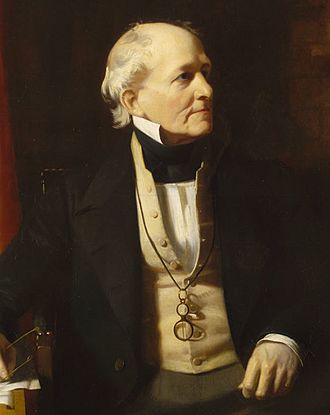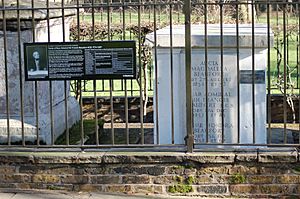Francis Beaufort facts for kids
Quick facts for kids
Francis Beaufort
|
|
|---|---|

Beaufort c. 1851
|
|
| Hydrographer of the Navy | |
| In office 19 May 1829 – 25 January 1855 |
|
| Preceded by | Sir Edward Parry |
| Succeeded by | John Washington |
| Personal details | |
| Born | 27 May 1774 Navan, County Meath, Ireland |
| Died | 17 December 1857 (aged 83) Hove, Sussex, England |
| Resting place | St John's Church Gardens |
| Spouses |
|
| Children |
|
| Parent |
|
| Relatives |
|
| Occupation | Hydrographer, mariner |
| Known for | Beaufort cipher, Beaufort scale |
| Awards | |
| Military service | |
| Branch | |
| Service years | 1790–1855 |
| Rank | Rear admiral |
| Wars | |
Rear-Admiral Sir Francis Beaufort (born May 27, 1774 – died December 17, 1857) was an Irish hydrographer and a high-ranking officer in the Royal Navy. He is famous for creating two important things: the Beaufort cipher (a secret code) and the Beaufort scale (which measures wind speed).
Contents
Early Life and Learning
Francis Beaufort came from a French Protestant family who moved to Ireland. His father, Daniel Augustus Beaufort, was a clergyman and a smart person who made a new map of Ireland in 1792. Francis grew up in Wales and Ireland.
He left school at 14 to go to sea, but he never stopped learning. He taught himself so much that he became friends with many great scientists of his time.
Francis knew how important accurate maps were for sailors. When he was 15, his ship was wrecked because of a bad map. This experience made him want to create better nautical charts.
A Career at Sea
Francis Beaufort began his career on a merchant ship. During the Napoleonic Wars, he quickly moved up the ranks in the Royal Navy. He became a lieutenant in 1796 and a commander in 1800.
He served on the ship HMS Aquilon in a big battle in 1794. Later, while on HMS Phaeton, he was badly hurt in 1800 during a mission near Spain. While he was recovering, he helped his brother-in-law build a semaphore line (a system for sending messages using signals) from Dublin to Galway.
Becoming a Captain
Beaufort returned to active duty and became a captain in 1810. While other officers relaxed, Beaufort spent his free time measuring ocean depths, finding locations using stars, and mapping coastlines. He used all this information to create new, accurate charts.
The British Admiralty (the government department in charge of the navy) gave Beaufort his first ship to command, HMS Woolwich. He sailed it to the East Indies and brought a group of merchant ships safely back to Britain. After that, he was asked to map the Río de la Plata river in South America. Experts were very impressed with his detailed maps.
Exploring Anatolia
After commanding the Woolwich, Beaufort was given another ship, the Frederickstein. From 1811 to 1812, he mapped and explored the southern coast of Asia Minor (modern-day Turkey). He found many ancient ruins there. His work was stopped when he was shot and seriously wounded by Turks near Adana. He returned to England and finished his charts.
In 1817, he published a book about his travels called Karamania; or a brief description of the South Coast of Asia Minor, and of the Remains of Antiquity.
In 1829, at 55 years old, Beaufort was chosen to be the British Admiralty's Hydrographer of the Navy. This meant he was in charge of all the navy's mapping and charting. He held this important job for 26 years, longer than anyone else.
During his time, the number of new charts produced grew hugely, from 19 in 1830 to 1230 in 1855. He also oversaw important scientific work. He played a big part in the search for Sir John Franklin, an explorer who got lost trying to find the Northwest Passage (a sea route through the Arctic).
Beaufort was also very interested in science beyond just navigation. He used his position to connect scientists with the Hydrographic Office, which could help fund their research. In 1849, he helped publish a guide called the Admiralty Manual of Scientific Enquiry. This book helped navy personnel and travelers do their own scientific investigations.
Supporting Great Discoveries
Beaufort helped make sure that Charles Darwin joined the famous voyage of HMS Beagle. Darwin's discoveries on this trip later led to his famous theory of evolution. Beaufort also convinced the Board of Trade to create a weather department, and Darwin's friend, Robert FitzRoy, became its first director.
Beaufort also helped get money for an Antarctic trip by James Clark Ross from 1839 to 1843. On this trip, scientists made many measurements of Earth's magnetic field.
He also pushed for better tide tables around Britain, publishing the first Admiralty Tide Tables in 1833. This inspired similar research in other countries.
By the time Beaufort retired, the Admiralty had created 2,000 charts that covered seas all over the world.
Later Life
Beaufort retired from the Royal Navy in 1846, at the age of 72. He was given the title "Sir Francis Beaufort" in 1848, becoming a Knight Commander of the Bath.

Sir Francis Beaufort passed away on December 17, 1857, at 83 years old. He is buried in London. His home in London is marked with a special blue plaque to remember his life and achievements.
Family Life
Francis Beaufort married Alicia Magdalena Wilson first. They had three daughters and three sons who were still alive in 1859. One of his sons, Francis Lestock Beaufort, worked in India. His daughter, Emily Anne Smythe, became a writer and helped change how nurses were trained.
After Alicia died, Beaufort married Honora Edgeworth in 1838.
What He Left Behind
Wind Force Scale
Early in his career, Beaufort created the first versions of his Wind Force Scale. This scale helps sailors and weather forecasters describe how strong the wind is. For example, a "moderate Gale" on the Beaufort scale means the wind is blowing between 32 and 38 miles per hour. He also created a way to write down weather conditions in his journals.
Places Named After Him
Many places around the world are named after Francis Beaufort, including:
- Beaufort Sea (a part of the Arctic Ocean)
- Beaufort Island, in Antarctica
Secret Code
Beaufort also created a secret code called the Beaufort cipher. It is a type of substitution cipher, which means it replaces letters with other letters to hide messages.
Images for kids
See also
 In Spanish: Francis Beaufort para niños
In Spanish: Francis Beaufort para niños



